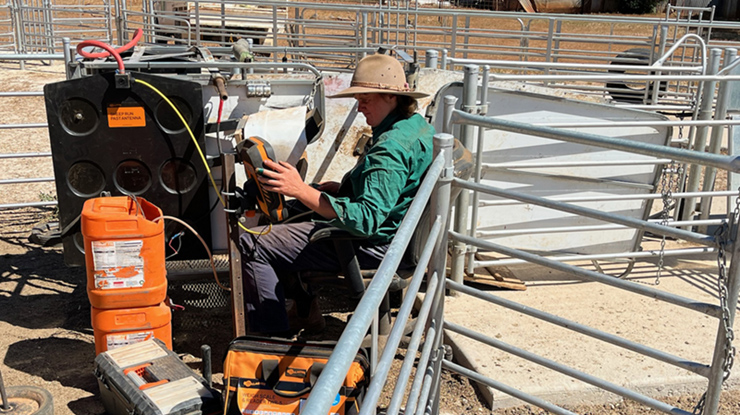 Upper-north SA sheep producer Alison Henderson conducts preg-scanning as a ewe management strategy. Image: Rachel Trengove, UNFS
Upper-north SA sheep producer Alison Henderson conducts preg-scanning as a ewe management strategy. Image: Rachel Trengove, UNFS
Detail in data delivers consistent lambing results
Fifth generation South Australian sheep producer Alison Henderson believes attention to detail is the key to running a profitable enterprise.
Participating in an MLA-funded ‘Lotsa Lambs’ Producer Demonstration Site (PDS) equipped her with the details and data to make informed decisions and maintain lambing results despite seasonal variability.
The Hendersons operate a mixed farm in the state’s mid-north. Their soft rolling skin (SRS) Merino enterprise includes both commercial and stud flocks, making data an important tool to maintain breeding objectives. Their flock is founded on Baderloo bloodlines, with the Hendersons acquiring the Baderloo Stud in 2024 in addition to Hendowie Stud.
Hendowie Stud have used Australian sheep breeding values (ASBVs) to make flock decisions since 2008, in conjunction with visual assessments. Selection traits include long staple and fleece weight, fat and muscle, and early growth. Specific targets are 1.3 lambs/ewe/year, 6kg wool, and lambs to grow out to 50kg within 7–8 months.
“Our breeding objective is to breed a dual-purpose, productive, balanced Merino sheep that thrives in a range of environments,” Alison said.
“If I’m going to push for reproduction, there will be sacrifices in areas such as growth, but having a clear breeding objective ensures a balance.”
They introduced electronic identification (eID) technology in 2018 and use AgriWebb to manage stock. BreedElite is used to record data such as wether lambs being born in twin or single mobs, ewe pregnancy status, visual traits and fleece weights.
Other genetic tools utilised include RamSelect, DNA testing in the stud flock, and the flock profile test for commercial sheep.
Livestock management
The Hendersons’ livestock management calendar includes shearing twice a year (mid-April and mid-October). They ceased mulesing wether lambs in 2018, and all lambs the following year.
They join for five weeks in February/March, which is timed to optimise conception rates as day length shortens, so ewes are lambing onto green feed in July/August.
The Hendersons have used pregnancy scanning since 2018 and automatically cull dry ewes when they are not in a flock-building phase.
“The preg-scanning technology enables us to better manage pregnant ewes, with more nutrition provided to smaller mobs of multiple-bearing ewes during pregnancy and lambing,” Alison said.
They lamb into separate twin and single paddocks so multiples can receive preferential nutrition.
Paddocks are split with electric fencing to allow for smaller twin-bearing mobs of around 100 ewes, while singles are run in mobs of 150–250 head. Identifying and splitting singles and twins has lifted lambing by 20% – up to around 120%.
The Hendersons’ nutrition strategies are based on principles adopted from the Lifetime Ewe Management (LTEM) program, such as condition scoring and feed budgeting.
“The LTEM course included training in body condition scoring, and I have used that ever since as a crucial tool to improve lamb survival and reduce ewe mortality,” Alison said.
“We have also found our feed rations are hitting the mark – condition scores give instant feedback on what’s working.”
They match land type to the enterprise where possible. Regular pasture paddocks have a medic base and sown pastures include a rotation of vetch.
Containment feeding helps the Hendersons bridge the autumn feed gap. They currently feed grain out in Poly Belt troughs (at a cost of $13–14/metre).
If there is an early break, ewes go into the paddock sooner to make the most of the feed on offer, topped up with supplementary feed. However, in the dry years of the PDS (2022 and 2024), they were supplementary fed from March until just before lambing in early June.
PDS results
The site Alison allocated to the PDS was a grazing block without a cropping rotation. During lambing, exposure is an issue and Alison intends to plant shelter belts in the future. In the meantime, she makes use of a north-facing slope and electric fencing to keep ewes in the most sheltered area.
“Paddock characteristics contribute significantly to lambing percentage. We’ve seen lamb survival rates increase by up to 10% in paddocks with shelter and reduced exposure to weather fronts when compared to poorer lambing paddocks lacking shelter, or which are close to trainlines or busy roads,” Alison said.
After scanning and separating ewes based on pregnancy status, ewes were put into containment with supplementary feeding. For this PDS, Alison aimed for 100 or less twin-bearing ewes in a mob for lambing.
Ewes are usually released from containment ten days before lambing to help preserve feed. However, in seasons with late breaks (2022 and 2024), supplementary feeding continues in the paddock to meet the ewes’ nutrition requirements.
The prolonged dry conditions of 2024 resulted in a very late seasonal break in June, which meant there was little or no feed available for lambing ewes. They had to rely on a full ration of supplementary feed to meet the ewes energy requirements during the lambing period.
Survival focus
The Hendersons already had low ewe mortality (2% or less), which Alison attributes to the role of genetics, specifically with their focus on fat and muscle, as well as the right nutrition.
They identified twin survival, through finetuning nutrition and lambing conditions, as a big opportunity to make productivity gains.
As part of the PDS, Alison weighed any dead lambs to build a picture of what was causing mortality – revealing that birth weight of under 3kg was a contributing factor.
“Our goal was to get twin lamb birth weights up to promote greater survival,” she said.
This was a challenge with ewe lambs in particular, where we tried to balance feeding for growth without too much weight gain (which can lead to dystocia).
Alison achieved ideal condition scores of an average of 3.5 at preg-scanning for all three seasons of the demonstration.
Seasonal challenges
Across the three-year trial, a range of seasonal challenges were experienced.
The late break in 2022 meant there was no green feed to lamb onto, contributing to the lambing results. Mismothering at feeders was an issue but with no feed on offer in paddocks, supplementary feeding was the only option.
There was an earlier break in 2023 with a useful 30mm of rain in April. Follow-up rain in May helped deliver nutritional green feed and pasture growth to lamb onto. This removed the need for supplementary feed during lambing and reduced mismothering. However, cold/wet snaps contributed to some mortalities from exposure.
Mob size was more than 100 head in 2024 because of low feed on offer due to drought conditions. With supplementary feeding, Alison managed to maintain condition scores at around 3.5 from joining.
Although seasonal conditions were different across the three years, Alison’s consistent lambing results demonstrate how implementing a combination of best practices can help achieve production targets despite seasonal challenges and feed gaps.
During 2024, the Hendersons also had the chance to see the impact of mob size when they purchased additional stud ewes. While these ewes were not included in the PDS, they provided a direct comparison as both were twinning mobs with one feeder and access to scrub areas for shelter.
The smaller mob (120 ewes on 4ha) produced 168 lambs (140%) whereas the larger mob (170 ewes on 7ha) produced 212 lambs (125%).
While the stand-out observation from the PDS was the benefits of smaller mobs, Alison also observed how other factors, such as lack of shelter, cold/wet snaps and genetics, impacted lamb survival.
The PDS reaffirmed Alison’s focus on breeding and selecting for lamb survival characteristics, such as fat and eye muscle area, which correlate with resilience.
Infrastructure and labour
Reducing mob size for lambing required investment in temporary fencing to split up paddocks.
Alison purchased two 500m electric fence kits with energisers and posts for $1,000, which enabled her to divide a 20ha paddock in half to run twinning ewes in smaller mobs. It took two hours to erect/deconstruct the fence.
Looking ahead, she plans on permanently splitting some of the paddocks to enable smaller mobs at lambing. Existing water points will enable these permanent areas to be reduced into smaller areas (10–15ha) with temporary electric fencing to be rotationally grazed over the growing season.
Figure 1: PDS results for Henderson’s trial site




